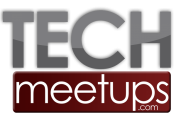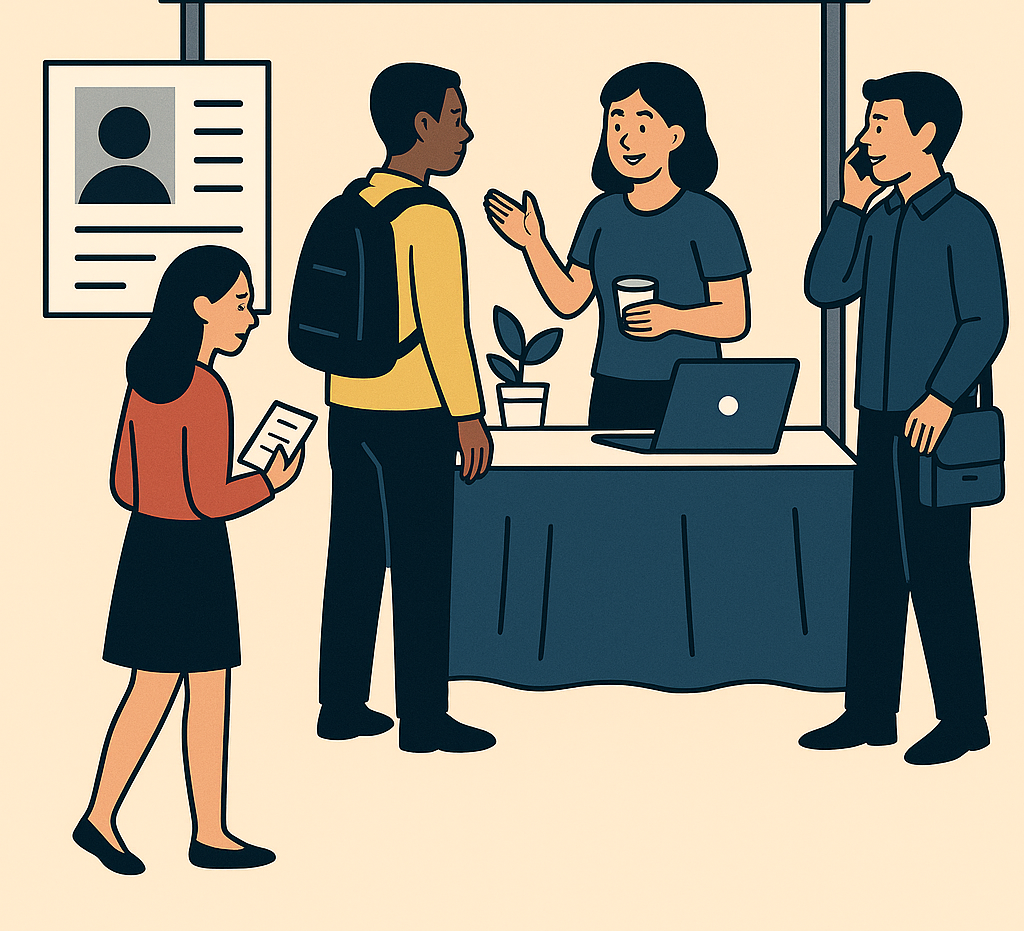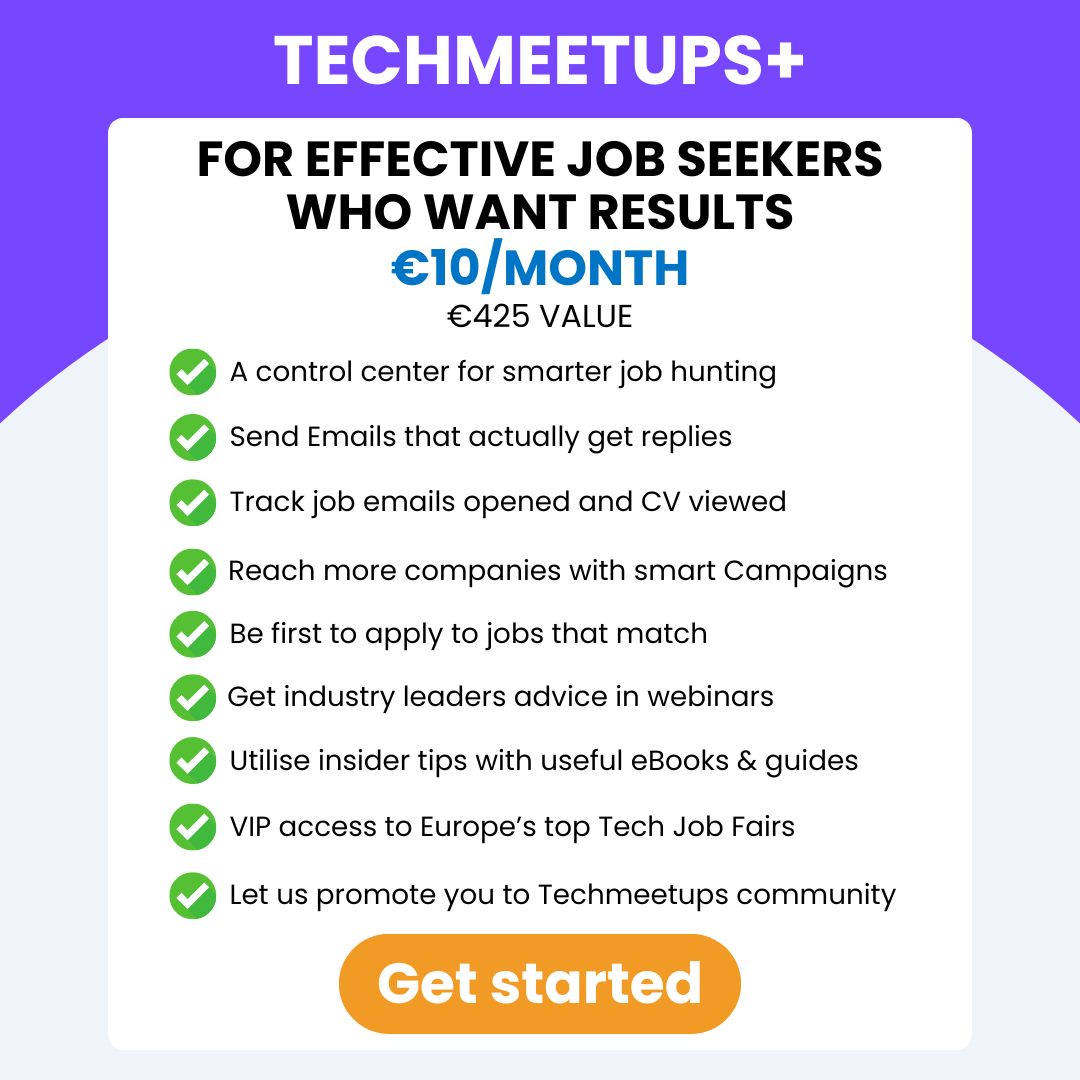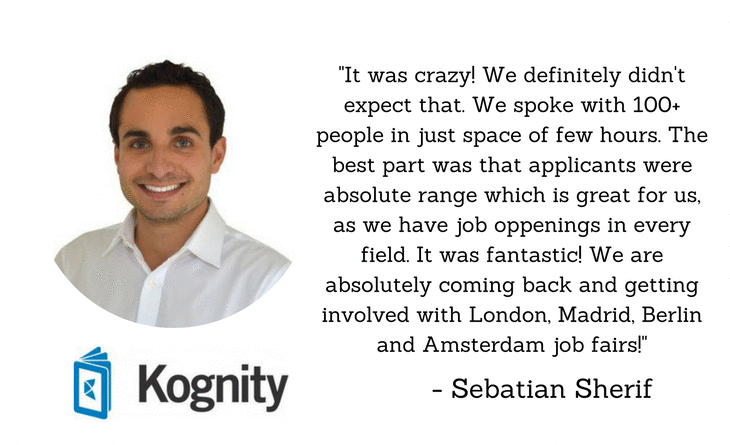Table of Contents
ToggleIntroduction
Tech job fairs are often viewed primarily as venues for immediate recruitment, where companies meet potential candidates and fill vacancies. However, the footprint of participating in such events extends far beyond the realm of instant hiring. These fairs offer a unique convergence of professionals and companies, fostering an environment ripe for networking, learning, and brand-building. In this blog post, we will explore how tech job fairs can serve as strategic investments, providing returns that influence a company’s industry standing and attractiveness to future top talent over the long term.
Building Long-Term Employer Branding
Visibility in the Tech Community
Participating in tech job fairs significantly boosts a company’s visibility within the tech community. These events are strategic platforms where businesses not only display their current successes and projects but also demonstrate their commitment to industry growth and talent development. This active participation is key in cementing a company’s reputation as a significant player in the tech field.
Examples of Visibility Impacts:
– Company Logos on Event Materials: By featuring their logos on lanyards, brochures, banners, and other promotional materials, companies gain repeated exposure throughout the event. This logo placement ensures that attendees frequently encounter the brand, increasing brand recall.
– Booths: A well-designed booth serves as a physical representation of a company’s brand and culture. It’s an opportunity to engage directly with event-goers, discuss what sets the company apart, and showcase innovations and successes. Tech job fairs often attract a wide array of participants from the tech industry, ranging from students and job seekers to industry leaders, providing a broad audience for brand messaging.
– Interactive Sessions and Demos: Hosting or participating in workshops, demos, or panel discussions at tech job fairs positions a company as a thought leader. These activities not only draw attention but also provide a platform to share knowledge and expertise, further enhancing the company’s standing in the community.
By leveraging these opportunities, companies can not only augment their visibility but also strengthen their status within the tech community, which is instrumental for long-term brand building and recognition.
Perception as an Employer of Choice
Interactions at tech job fairs are pivotal in molding a company’s image as an attractive and desirable workplace. These events provide an unparalleled opportunity to communicate directly with potential employees, allowing companies to project their values, culture, and benefits effectively.
Enhancing Employer Appeal through Interactions:
– Direct Communication: Job fairs allow for face-to-face interactions that can convey the company’s enthusiasm, commitment to employees, and workplace culture more effectively than digital communication. By engaging directly with job seekers, companies can discuss what makes their environment unique and appealing which helps to build a personal connection and leaves a lasting impression of a supportive and innovative workplace.
– Swag (Promotional Items): Thoughtfully designed promotional items can significantly boost a company’s memorability and appeal. Items such as T-shirts, mugs, tech gadgets, or other branded merchandise serve not only as gifts but also as a form of advertisement. They carry the company’s brand into potential candidates’ everyday lives, reminding them of the company long after the event has ended.
–Presentations and Pitch Sessions: Presenting company milestones, core values, upcoming projects, and advancements during a pitch session can attract top talent who are looking for dynamic and forward-thinking employers. Good presentations are not only informative but also inspirational, painting a picture of what it’s like to work at the company and the potential impact an employee can have.
–Interactive Sessions and Workshops: These sessions are opportunities to showcase the company’s expertise and industry leadership. By involving potential hires in discussions about cutting-edge technologies or industry trends, companies can stimulate interest and excitement about the work they do. This also demonstrates a commitment to learning and development, qualities that are highly attractive to top talent.
Through these methods, companies not only stand out at the job fair but also reinforce their reputation as top employers, making them more attractive to skilled professionals looking for their next career move. These proactive engagements are crucial for establishing a positive perception that lasts far beyond the duration of the event.
Impact on Future Hiring
Participating in tech job fairs goes beyond the immediate gains of filling current vacancies; it significantly influences future hiring cycles. The interactions and impressions made at these events can sustain a company’s recruitment efforts long-term.
Connecting Current Presence to Future Recruitment Cycles:
1. Building a Talent Pipeline: The relationships initiated at job fairs often turn into a reservoir of potential applicants. Even attendees who do not immediately apply for a job become part of a talent pool that companies can tap into later. Such engagements ensure a quicker and more robust candidate shortlisting process for future vacancies.
2. Data Collection and Lead Generation: During these events, companies collect resumes and contact information, enabling them to follow up with promising candidates who may not be ready to change jobs immediately but could be valuable assets in future hiring rounds. This proactive approach helps in maintaining an ongoing engagement with potential hires.
3.Long-term Relationship Building: Initial conversations at job fairs can evolve into long-term professional relationships. By nurturing these contacts through regular updates about company developments and future job openings, companies maintain visibility and interest among potential candidates.
The Role of Word-of-Mouth and Social Media Sharing Post-Event:
1. Amplifying Reach Through Attendees: Participants often share their experiences and the insights they gain at tech job fairs with their peers. Positive interactions can lead to word-of-mouth promotion, where attendees talk about their positive impressions with their networks, expanding the company’s reach and enhancing its reputation as a desirable employer.
2. Leveraging Social Media: Companies can extend the impact of their job fair participation by actively engaging in social media activities related to the event. Posting about their involvement, sharing photos from their booths, and highlighting any speeches or presentations can keep the momentum going. Engaging with attendees who post about the company can amplify their message and reach a broader audience.
3. Follow-Up Content: Creating follow-up content such as blog posts, newsletters, or thank-you emails for attending provides additional touchpoints for engagement. This content can recap the event highlights and keep the company in the minds of potential applicants, influencing their future employment decisions.
In conclusion, the impact of participating in tech job fairs on future hiring is profound. By establishing connections, fostering relationships, and ensuring continuous engagement through word-of-mouth and social media, companies can significantly enhance their recruitment outcomes over time.
Networking Gains
Building Industry Relationships
Networking is a cornerstone of any tech job fair, offering substantial opportunities to forge and strengthen relationships with a diverse cross-section of the tech industry. This networking aspect is not only about recruiting new talent but also about connecting with peer companies, industry leaders, and potential business partners.
Importance of Connections with Other Companies and Industry Leaders:
1. Access to Industry Trends and Insights: Interacting with other companies and industry leaders provides valuable insights into emerging technologies, market trends, and competitive strategies. These insights can help businesses stay ahead of the curve and adapt their strategies and products accordingly.
2. Shared Knowledge and Best Practices: Engaging in discussions with peers at job fairs allows companies to exchange ideas, experiences, and approaches to common challenges. This shared knowledge fosters innovation and efficiency, enhancing a company’s operational and strategic prowess.
3. Reputation and Credibility: Building relationships with well-known industry leaders and reputable firms can enhance a company’s credibility within the tech community. This enhanced reputation can attract better talent, more customers, and potent investors.
Potential for Partnerships and Collaborations:
1. Strategic Alliances: Connections made during tech job fairs can lead to strategic alliances where companies can collaborate on projects, share resources, or co-develop products. These partnerships can open new markets and extend a company’s reach beyond its existing capabilities.
2. Joint Ventures: Through interactions at job fairs, companies might identify synergistic opportunities that lead to joint ventures. These ventures can leverage the strengths and capabilities of both partners to explore new business opportunities or innovations that would be challenging to pursue independently.
3. Vendor Relationships: Tech job fairs are an excellent arena for companies to meet potential vendors or service providers that can enhance their operational effectiveness. Building a network of reliable vendors is crucial for maintaining quality and efficiency in business operations.
4. Mentorship Opportunities: Interactions with seasoned industry leaders can open up mentorship opportunities for younger companies and startups. Such relationships are invaluable for gaining strategic advice and guidance, navigating challenges effectively, and accelerating growth.
By actively participating in tech job fairs, companies not only position themselves favorably for immediate hiring benefits but also strategically enhance their industry relationships, paving the way for future collaborations and innovations. This comprehensive approach to networking significantly strengthens a company’s standing and influence within the tech community.
Learning and Innovation
Tech job fairs are critical for sparking internal improvements and innovations. These events offer direct exposure to new technologies, best practices, and the latest industry standards which can catalyze significant internal development.
How Insights from Job Fairs Drive Innovation:
– Adoption of Emerging Technologies: Discover new tools and technologies that can streamline operations and enhance product offerings.
– Implementation of Best Practices: Learn from industry leaders about efficient practices that can be integrated into daily operations.
– Benchmarking: Evaluate and adjust internal practices by comparing with industry standards observed at the fair.
Examples of Actionable Takeaways from Past Fairs:
– Agile Methodologies: A company adopted Agile frameworks after learning about its benefits at a fair, leading to quicker product development cycles.
– Remote Collaboration Tools: Insights into remote work trends encouraged a company to implement advanced collaboration technologies, enhancing productivity.
– Enhanced Cybersecurity: Exposure to the latest cybersecurity strategies prompted a company to upgrade its security measures, better protecting its data.
These learnings not only keep companies competitive but also foster an environment ripe for continuous growth and technological advancement.
Engaging with Tech Talent
Effective engagement with tech talent at job fairs is crucial for attracting and retaining high-quality candidates. It’s about making meaningful connections that not only fill immediate vacancies but also build a talent pipeline for the future.
Strategies for Meaningful Engagement During the Fair:
– Interactive Demonstrations: Set up hands-on demonstrations of your technologies to engage attendees in a way that showcases the practical work and innovation happening at your company.
– Live Challenges or Competitions: Host coding challenges or live problem-solving sessions. These not only make the fair experience more interactive but also allow you to see potential candidates in action.
– Q&A Sessions: Organize sessions where candidates can ask questions directly to your teams, including HR and technical staff. This transparency builds trust and helps candidates feel more informed about your company culture and opportunities.
– Personalized Conversations: Train your team to engage in genuine, one-on-one conversations with attendees. Personal interactions can leave a lasting impression and make candidates feel valued.
Long-term Benefits of Early Interactions with Potential Candidates:
– Building a Talent Pool: Early interactions at job fairs help you create a database of promising candidates whom you can reach out to for future roles, reducing time and costs associated with talent acquisition.
– Internships and Co-op Placements: Engaging with students and recent graduates can lead to internships and co-operative placements. These opportunities allow both the company and the candidates to evaluate a potential long-term fit before a full-time role is offered.
– Enhanced Employer Branding: Positive engagement at job fairs enhances your reputation among potential candidates. Happy candidates who have a good interaction, even if they don’t end up working for you, are likely to speak positively about their experience, enhancing your image as an employer of choice.
– Feedback Mechanism: Interaction with numerous candidates provides feedback not just on their capabilities but also on how they perceive your company and what they expect from potential employers. This can be crucial information for adjusting your recruitment strategies and employer branding efforts.
By using these strategies, companies can maximize their impact at job fairs, turning them into valuable opportunities for building lasting relationships with future tech leaders. These early, meaningful engagements lay the groundwork for a robust recruitment and retention strategy, proving advantageous in the competitive tech industry landscape.
Measuring ROI
Qualitative Benefits
While the ROI of participating in tech job fairs is often associated with quantitative metrics like the number of hires, the qualitative benefits related to brand image and network quality can be equally significant.
Impact on Brand Image and Network Quality:
– Enhanced Brand Perception: Participation in job fairs can boost a company’s image as an innovative and desirable place to work, enhancing its reputation among both job seekers and peer organizations. This improved perception helps attract top talent and potentially new business partnerships.
– Strengthened Industry Connections: Regular attendance and engagement at job fairs strengthen relationships with peers, industry leaders, and potential collaborators, thereby enhancing the quality of a company’s professional network.
Methods to Gather Qualitative Feedback:
– Surveys and Questionnaires: Post-event surveys can be sent to both attendees and company representatives. These should ask about their experiences, perceptions of the company, and the overall effectiveness of the event engagement strategies.
– Social Media Monitoring: Analyze comments, tags, and shares on social media related to the event to gauge public sentiment and engagement levels. This can provide insights into how the brand was perceived during the fair.
– Follow-Up Interviews: Conduct brief interviews with key contacts made during the fair to discuss their impressions and takeaways. This direct feedback can be incredibly valuable in assessing the impact on brand image and network.
– Focus Groups: Organizing focus groups with a selection of participants after the event can provide deep insights into the company’s performance at the fair and perceptions of the brand.
By effectively measuring these qualitative benefits, companies can better understand the broader impact of participating in tech job fairs beyond immediate hiring results. This understanding helps refine strategies for future events, ensuring continuous improvement and maximization of ROI.
Quantitative Metrics
Quantitative metrics are essential for clearly demonstrating the return on investment (ROI) of participating in tech job fairs. These metrics help in evaluating the direct and indirect benefits derived from the event.
Possible Metrics to Measure the Impact:
– Number of Applications Received: Track the number of applications submitted for job openings advertised at the fair, providing a direct measure of initial interest generated.
– Number of Follow-Up Interviews Scheduled: Monitor how many interviews are scheduled with candidates met at the fair. This indicates the quality of leads generated from the event.
– Hire Conversion Rate: The ratio of attendees who apply and are eventually hired is a crucial metric. This showcases the effectiveness of the job fair in sourcing viable candidates.
– Increase in Social Media Engagement: Measure spikes in followers, likes, shares, and overall engagement on the company’s social media platforms post-event to gauge brand exposure.
– Event-Specific Landing Page Traffic: Analyze traffic to a dedicated event landing page before, during, and after the fair to measure interest levels and engagement.
Tools and Techniques for Tracking These Metrics Over Time:
– Applicant Tracking Systems (ATS): Use ATS to track applications, sort candidates, and monitor the hiring stages of applicants sourced from job fairs.
– CRM Systems: Customer Relationship Management (CRM) tools help in managing and analyzing interactions with potential hires and business contacts made at the fair, enabling the nurturing of these relationships over time.
– Google Analytics: Implement Google Analytics to monitor the web traffic and behavior on specific recruitment pages connected to the job fair, providing insights into user engagement and the effectiveness of promotional efforts.
– Social Media Analytics Tools: Platforms like Hootsuite, Sprout Social, or native analytics tools on social media platforms provide comprehensive data on engagement metrics, helping assess changes in brand interaction post-event.
– Survey Tools: Tools like SurveyMonkey or Google Forms can be used for sending out post-event feedback forms to participants, measuring satisfaction rates and gathering practical insights to improve future participation.
By regularly tracking these quantitative metrics, companies can gain a clear understanding of their job fair activities’ effectiveness, allowing for data-driven decisions and strategy optimizations for future events. This analytical approach ensures that each participation is geared towards maximizing ROI and achieving set recruitment and branding goals.
Conclusion:
Participating in tech job fairs offers a wealth of benefits that extend far beyond the immediate scope of recruitment. These events serve as pivotal platforms for not only sourcing top-tier talent but also for bolstering a company’s brand image, expanding its industry network, and absorbing cutting-edge insights that can drive innovation and strategic growth.
Broader Benefits:
– Enhanced Employer Branding: Tech job fairs provide a unique venue to reinforce your image as an employer of choice, attracting future talent and establishing your place within the industry.
– Strategic Networking:** These events open doors to forging valuable relationships with industry leaders and potential partners, facilitating collaborations that could be transformative for your business.
– Learning and Innovation:** Exposure to new technologies and practices at these fairs can inspire significant internal improvements, fostering an environment of continuous learning and innovation.
– Engagement with Potential Candidates:** Early interactions with prospective hires can build a robust pipeline for future recruitment and internships, contributing to long-term staffing solutions.
– Quantifiable Returns: With the right tools to measure both qualitative and quantitative outcomes, companies can clearly see the ROI from these engagements, guiding more informed decisions for future participations.
Conclusion
Looking forward, adopting a strategic mindset for participating in tech job fairs is crucial. These events should be seen as long-term investments rather than one-time recruitment opportunities. Effective participation involves meticulous planning, aligning with broader business objectives, and active engagement in learning and networking. This approach not only enhances immediate outcomes but also fosters sustained growth and continuous improvement, securing a company’s success in the competitive tech industry.
We invite you to share your experiences and insights on participating in tech job fairs. Whether you’re a seasoned participant with stories of success and lessons learned, or a newcomer seeking tips and strategies, your perspectives enrich our understanding and enhance our community’s collective knowledge.
If you have ideas, questions, or are interested in discussing potential collaborations, please reach out to us. We are keen to explore opportunities that can mutually benefit and drive forward our objectives in the tech industry.
Contact us at alexandra@techmeetups.com or follow this link to submit your thoughts and queries: www.techmeetups.com Let’s connect and collaborate to make the most of tech job fairs, transforming them into pivotal milestones for growth and innovation in our careers and busines






